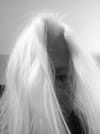Doll and Ruby Easson: Twin Sisters and Endlings
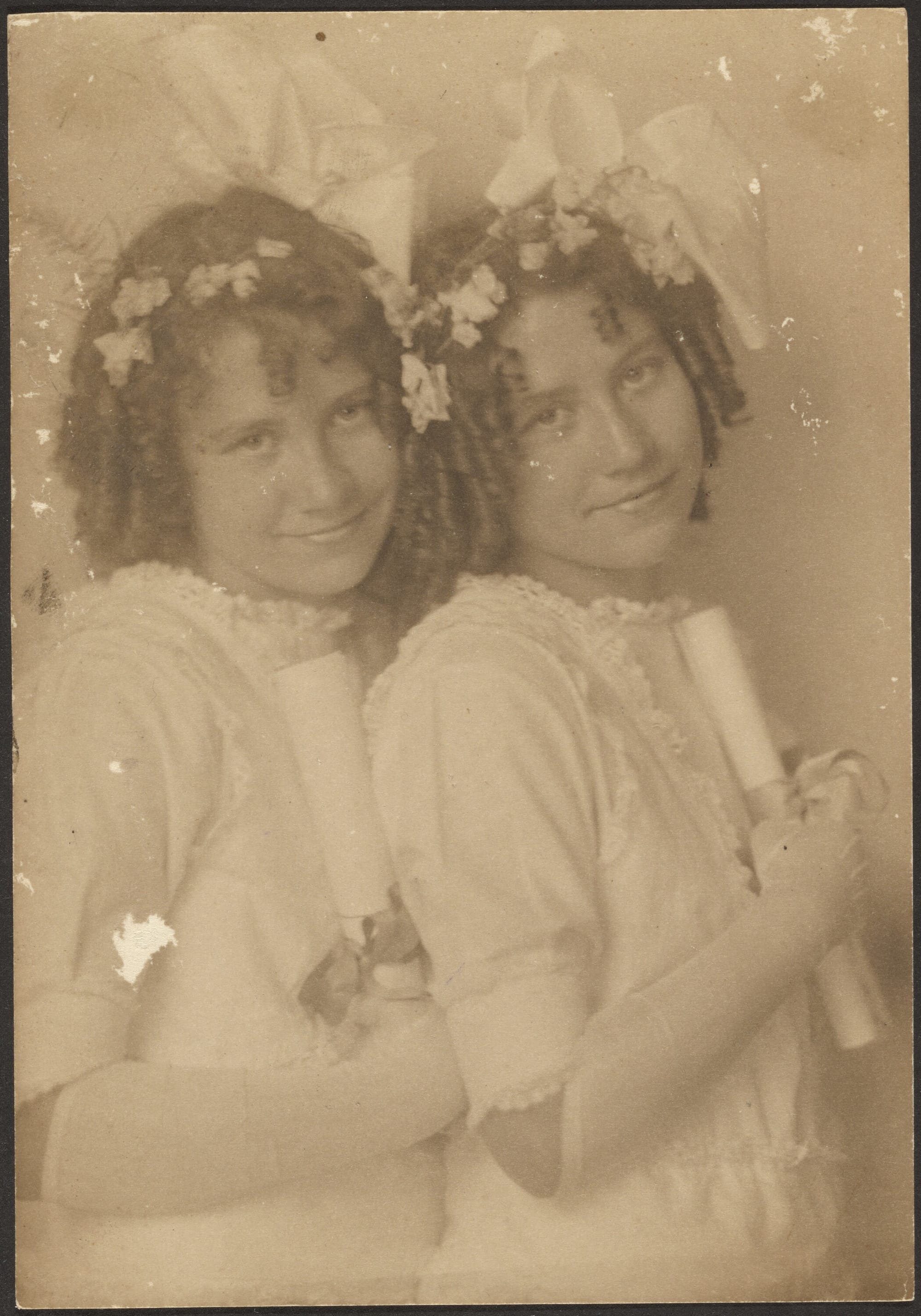
A Tap on the Shoulder
Damnatio Memoriae
According to some authorities of history and population studies, about 117 billion people have been born on this earth.
How many are forgotten? I would guess almost every single one; yet in my imagination, a few still stand and some still walk.
In the ruins of ancient Rome you can sometimes find tombstones with engravings saying words like “Stop, Traveller and Read”, which often included additional insights into biography, eulogies or other tidbits about the person being remembered. To be forgotten was a dire punishment in the ancient world — even worse was to be intentionally forgotten: statues destroyed, written words struck from the records, paintings scratched away, effaced.
In Rome this practice was called “Damnatio Memoriae” (actually the phrase originated in Germany in the 1600s to explain the intent of it) and it meant “condemnation of memory” — an erasure of the person in the most complete way.
Doll and Ruby Easson almost slipped away, an unintentional Damnatio Memoriae event. They are only a sliver of history, but still fellow travellers in time.
They are figures lost to time, slipping away from the world unseen, only revealing themselves in tiny shreds, channelled through crumbs of history, census data, newspaper clippings.
At one point, these two women walked the same streets as I, and lived in the same house. They pushed forward, in those times and places; but what they ultimately became seems utterly lost.
How I found Doll and Ruby, Or How They Found Me
What do you call those people you never met but in whose footsteps you tread?
Perhaps I did meet them back in 1961, but if so, I don’t remember it.
While working on another project, I was researching voter list archives and, for no particular reason, I decided to check records pertaining to the house in which I now live. A little backstory: I moved here with my parents in 1961. In the 1970s I moved away for a few decades and when my parents died, I moved back into the house. So, this story has its origin in 1961, but ripples back and forth through time.
Our house has been owned by two families. The first owners were an older, married and childless couple, Herbert and Ann Darbyson. Then my family became the second owners. The house was built in 1956 and the Darbysons had lived here for five years.
Our paths crossed with Doll and Ruby, only we didn’t know it.
Four Odd or Minor Coincidences
- I do recall briefly meeting Mr. and Mrs. Darbyson. My recollection is that they were old, but then, to a small child (I was 3 years old at the time), everyone over twenty seemed decrepit. What I had been excited about was the front screen door. Back in 1950s and 1960s suburbia it was typical to have the owner’s surname initial featured in curlicue script on the lower half of the front door screen. Their initial was, of course, “D” for Darbyson. I recall being delighted, commenting that the door had “my letter” on it (my name, in case you’ve forgotten, is Denise).
We moved in, and over time my parents made changes to the property. Then, returning here in 2006, I made more. Still many things remained the same throughout the decades — some as a matter of preference, some as nostalgia, some because of the expense of a change. - After selling the house to my parents, the Darbysons (as I just learned through the voters’ lists) moved to Denise Street in Mississauga.
- A few houses north from the Darbysons there was a home owned by the Hill family — this will become significant as the story unfolds.
- Back to the voter’s list. At my address, in the late 1950s, there were two other people living there with the Darbyson couple: Doll and Ruby Easson.
At the time of my parents’ home purchase (1961), my father was a computer systems analyst — a decidedly unusual profession for the time. And I discover that the previously unknown Doll and Ruby were computer operators — an even more unusual occupation for a woman!
This is weird.
If you knew my Mother, you would know that she would have normally been aware of all the details of the previous owners of the home — their names, their professions, any idiosyncrasies. And she would certainly have told me all about them. The fact that she never mentioned Doll and Ruby confirms that she had no idea that they lived here.
How a Passing Curiosity Develops into a Moderate Obsession
I suppose that the reaction to this discovery and the odd coincidences would, for most “normal” people, be something along the lines of “Well, isn’t that interesting? So, what’s for dinner tonight?". But not me.
I began to ponder my having crossed the paths of these hitherto unknown women for years, for decades, unknowingly. Where they walked, I walk. What they saw, I see, what they smelled and touched, I smell and touch. And some of their experiences, these place-specific ones, are very different now and some are still exactly the same.
Then there is the pathos: Doll and Ruby died childless, and alone. Ruby was the first to go in 1985 and Doll followed her in 1993.
The Endlings
The term “endling” was coined in correspondence in the scientific journal “Nature” in 1996. It denotes the last known individual of a species (or subspecies) and usually refers to a creature from the animal kingdom. Once an endling dies, the species is extinct.
Ruby and Doll are endlings. They are not even footnotes to a footnote. They are not even slivers of history. Almost all traces of them have been obliterated, as though they never existed. Time, it seems, has removed any remnants of their existence.
When they died, did either of them finding themselves staring into the abyss of the meaninglessness of their lives, of their achievements? Did anyone take note or mourn their departure, other than the notice to creditors in the local newspapers?
Doll and Ruby were both cremated, so there is not even a stone to visit or to lay a bouquet of flowers upon. Did Doll collect Ruby’s ashes, and if so, where did she release them? Or did she keep an urn in her last home? When Doll was burned, who collected her remains and what winds received them? Or were the ashes of both women discarded ignominiously, consigned to the trash?
And this is where I start to entertain a moderate obsession. Indeed, who were these elusive women?
Daylighting Doll and Ruby
The past is never gone, it’s just buried or camouflaged.
Urban planners use the term “daylighting” which they apply to rivers and streams that over time have been buried or imprisoned underground (usually as a result of development). These bodies of water, that at one time flowed visibly above ground are confined to drains and tunnels, only discernible as a whisper in a manhole cover or near a drain, are restored to the flow upon the surface, beneath daylight again.
Exhuming the story of Doll and Ruby was difficult. As far as I know, there are no diaries, no journals, no written records of their existence. There are only the smallest shreds of evidence, passing by like ghosts or small birds circling overhead.
The character of Thorin Oakenshield in J.R.R. Tolkien's The Hobbit said:
There is nothing like looking, if you want to find something. You certainly usually find something, if you look, but it is not always quite the something you were after.
The Mystery of Doll and Ruby
First of all, they were twins; I don’t know if they were identical or fraternal twins, but twins they were indeed.
Secondly, they had several different varieties in their given names. Doll was known as Dolly, or Bessie, or Betsey, or Betsy. Ruby went by Robina or Rubina.
Some believe the opposite of Damnatio Memoraie: that people can live forever so long as the names were remembered.
Some cultures believe that names are important: If children are given common and popular names, the gods will not notice them. It is the unusual names that would draw attention — either good or bad. Doll and Ruby had several given names and three different surnames, a combination of the usual with the unusual. A temptation to fate indeed.
I was unable to find proper documentation of exactly when and where they were born, but I did find some clues in various documents and obituaries. The two girls were born, likely in Dundee, Scotland between 1908 and 1911.
For the moment it seems impossible to find a reliable (or any) record of their birth; not only because of the general difficulty in finding these things, but also because they weren’t born as “Easson”, but rather with the surname “Hill”. More on this later.
The Easson/Hill Family
Here is what I’ve managed to discover about the twins and their heritage.
These early generations are a little shaky on documentation, but Doll and Ruby’s grandparents were likely Alexander Hill and Margaret Mitchell Easson. Alexander (b. 1820) and Margaret (b. 4 June 1835) were married in Dundee (Angus) Scotland on New Year’s Eve, 31 December 1856. Alexander was 36 years old and his bride was significantly younger, at 21 years of age.
Granny Margaret Mitchell Easson was possibly the daughter of a Thomas Easson, also from Dundee. Thomas was born sometime between 1798 and 1806. He was an agricultural labourer.
Thomas married a woman by the name of Jean Morrison, but there isn’t much information about her.
What further confuses the family history is that their surname is recorded at times as “Cassen” or similar variants[1].
In any case, Thomas appears in an 1841 census as living on Union Street in Maxwelltown, Dundee, along with a spouse named “Lenia”, five years his junior, and children Margaret (age six), Elizabeth (age four) and James (age two). “Lenia” could be a severe spelling error of “Jean”.
In any case, the date for Margaret matches that of her birth. Thomas’ death isn’t clear — there is a span of years from prior to 1851 up to 1873 when he may have died.
Alexander Hill and Margaret Mitchell Easson
It looks like Alexander and Margaret had ten children.
Once we reach 1851, the unmarried Margaret is once again found in the census records. Living in Dundee in Jamaica St. (in the Hilltown area), she was a weaver, living with her mother Jean (age 40), her sister Elizabeth (age 14), brother James Douglas (twelve) and two grandchildren of Jean: Robert Douglas Hill (aged eleven) and Elizabeth Douglas (age nine). Only Margaret was working.
In this same year, her husband-to-be, Alexander, was living at 185 Hills Land, as a “lodger” with Thomas Hill (perhaps his father-in-law).
In the 1861 census, Margaret was living at 182 Hilltown, Dundee and was a “weaver’s wife”, but Alexander does not appear to be living with them. Those who are listed are James (age two), Robert (age 73, which is certainly wrong), Archibald (less than six months old).
In the 1871 census, we find Margaret living with an aunt named Jane Watt (60 years old), but in a different area of Dundee. Margaret is listed as a spinster (meaning “weaver”; this did not refer to her marital status).
In 1881 Margaret (age 56) is living with her husband Alexander (age 70) at 201 Hilltown in Dundee. He is listed as a hand loom weaver. With them are their children Peter (16), Margaret 14), Thomas (nine), David (six), and Elizabeth (four).
Come 1891 Margaret and Alexander were living at 191 Hilltown in Dundee. Both were weavers; Margaret is listed as a “carpet weaver”. Living with them are their children Thomas (age 19), David (17), Elizabeth (15).
Margaret’s last appearance in a Scottish census was in 1901 where we find her and Alexander still at 191 Hilltown, but only the grandson Peter is still with them.
It is not known where or when Alexander or Margaret died.
Doll and Ruby’s Parents
William Hill was born to Alexander and Margaret sometime between May 20, 1869 and 1872. William is elusive. There is no mention of him in various Scottish census data. He may have been living with other relatives.
At some point, William immigrated to Canada, but the record of his passage is lost to us. Whether he married in Scotland or in Canada seems impossible to confirm, but his marriage likely happened in Scotland.
In what would appear to be a family tradition, the woman he married had several variants of her name: Sometimes Bessie or Betsey or Betsy or Elizabeth Cuthbert Adamson (and occasionally is mentioned as Anderson). Her birth-date is also hard to pinpoint — sometime between 1868 and December 24, 1873. We’ll call her “Bessie” from here on.
Bessie’s parents may have been Robert Adamson and Ann Anderson from Dundee, but there is no firm documentation. “Cuthbert” may have been a family name, or perhaps the name of an early first marriage, but it seems impossible to determine now.
Finally there is some documentation to establish the whereabouts of Bessie and her children — and the first time we see a record of the twins, Doll and Ruby.
On June 7th, 1912, the manifest of the ship Athenia lists a Presbyterian family who disembarked in Quebec, on their way to Collingwood (!!) Ontario. There we find a married Bessie Hill (40), son Albert (eleven), daughter Annie (no age), son Willie (seven), son Ralph (three) and daughters Robina and Bessie (perhaps 4½ months or years old - the manifest is smudged here).
The Athenia and 440 Dead Horses
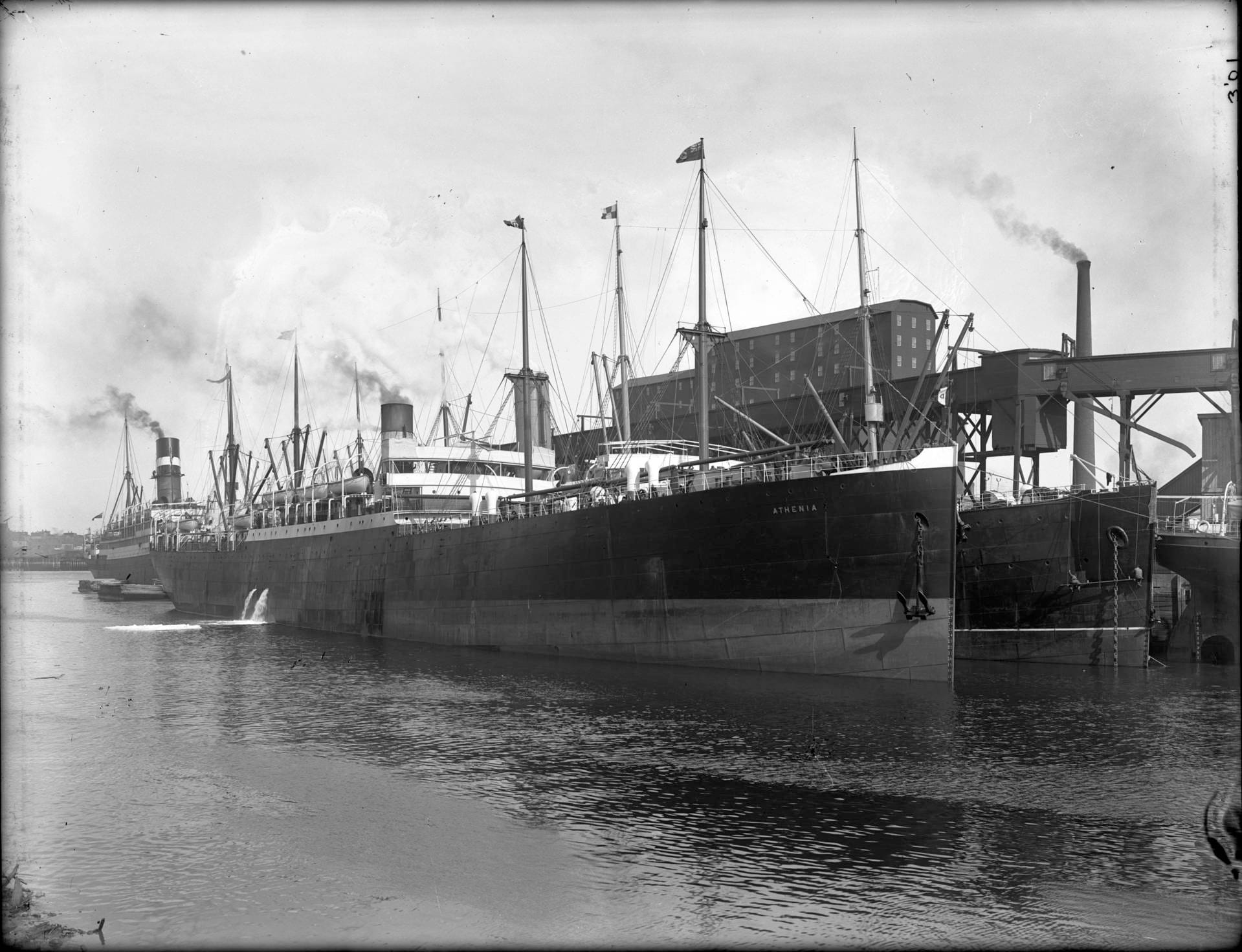
There is more than one ship named “Athenia” — the very young Doll and Ruby sailed on the one built in Glasgow in 1903, and her maiden voyage to Canada took place in 1904. Built for the Clyde-Canada service, she was 478 ft long, could do 14 knots, and had accommodations for only twelve first class passengers. This capacity was deemed unsuitable, and in 1905 the line added space for 50 second class and 450 third class passengers. Her first voyage at that capacity was in May 1905, heading from Glasgow to Montreal via Saint John, New Brunswick.
Just a few years after Doll and Ruby made their crossing, the Athenia (which had been commandeered by the military during WWI) was torpedoed, and sank just north of Ireland on August 16th, 1917. She was on her way from Montreal to Glasgow and in the process of repatriating the crew of HMHS Letitia. While steaming at 20 knots, she was hit about six metres from her stern: 15 crew and passengers were lost, as were 440 horses.
A small “aside”: Although it is tragic that 15 lives were lost, I felt a terrible sense of sadness about the horses. I imagine that they were penned up below decks and drowned trapped. And for what? For nothing. But I digress.
Although Doll and Ruby were far too young to remember the voyage or the ship, it is still poignant to think that yet another trace of their existence is forever gone.
There was no husband travelling with the family.
The First Change of Surname
It is sometime after 1921 that their surname changed to Easson, the maiden name of William’s mother.
The family makes its first Canadian appearance (other than on the Athenia) in the 1921 Census of Montreal. They are living at 2969 Notre Dame in Maisonneuve. Here we find some oddly inconsistent information:
- Eason William Hill, age 49, born 1872 in Nova Scotia, who immigrated to Canada in 1910. He informs the enumerator that his father was born in Scotland and his mother in Nova Scotia. He is a Roman Catholic (‽), a “worker”, and has a five-room rental apartment that costs $22/month. His income is $1600/year.
- Bessie Hill, age 48. Born in Nova Scotia in 1873, a Presbyterian born of a Scottish father and a Nova Scotian mother.
- Albert Hill, age 21, born in Nova Scotia, but immigrated to Canada in 1912. His father was born in Scotland and his mother in Nova Scotia. He is Presbyterian, an engineer by trade and makes $600 a year.
- Anna Hill, age 20, born in Nova Scotia in 1901, immigrated in 1912. She is a stenographer and makes $800 a year.
- Bessie and Rubina, born 1910 in Nova Scotia, and are school children.
Two other siblings of Doll and Ruby are missing from the record:
- William “Bill” Hill (likely “Willy” from the Athenia manifest);
- Ralph is also absent.
Nova Scotia, Collingwood, Montreal, Dundee — Where in the World?
Either the census enumerator was sloppy, or the family was lying, or possibly both. The name “Easson” does not appear in the records yet other than as William Hill’s first name, written "Eason".
There doesn’t seem to be any record of a William/Bill Easson/Eason/Hill in Collingwood between 1910 and 1912. Perhaps he went there; perhaps his family joined him there. In any case, they did not stay and ended up in Montreal.
Despite the information given in the census, by 1917 the family had been using “Easson” as their surname. In June of that year, the Montreal Star noted that at the Maisonneuve School, Ruby achieved a mark of 93% in Kindergarten, and there is an “Olive” Easson in the same class who clocked in at 86%. In June of the following year, both Doll and Ruby Easson are listed as having graduated Grade 1.
Yet Another Surname Iteration
It took a little sleuthing to find this elusive family in the 1931 census records. Living at 7028 Champagneur Rd., their surname had now morphed into “Hilleasson”. Ruby and Doll were now listed as Robina and Bessie, both age 21 and were “computer operators”. Both were earning $960 a year, and it would appear that they were the only income generators in the family, now reduced to the twins and their parents, William and “Betsy”.
Their sister Ann, now married to Herbert Darbyson (the couple we would later buy our house from) was living next door at 7026 Champagneur.
The census further specifies that the father William arrived in Canada in 1910, while his wife and twin daughters came later in 1912. William calls himself a “coppersmith” but has been unemployed for at least one year.
Early Computer Operators
Ruby worked at a tobacco manufacturer, most likely Imperial Tobacco, although there were a couple other smaller tobacco outfits in Montreal in the 1930s. Doll was doing the same type of work but at a chain store (there were several department stores in Montreal at the time, so it would be hard to speculate which one employed her).
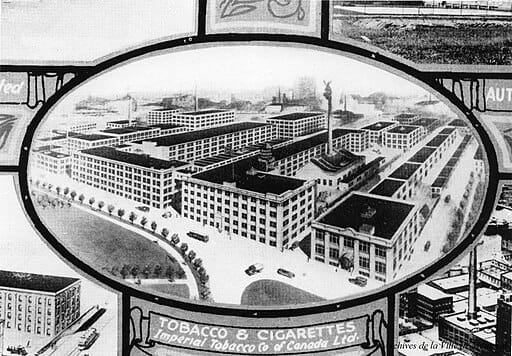
Computers in the 1930s (and earlier) were people who computed (often using a mechanical tabulating machine). Although, it seems likely that Doll and Ruby did have some early involvement with electronic computers, as that became their work in the 1950s and 1960s.

In that time, many women were engaged as computer operators, which involved physically connecting cables and wiring. Although important, when women performed the job it was viewed more as “clerical” in nature rather than technical.
Moving In With Their Sister
The twins’ older married sister Ann, who had been living next door to the Eassons, moved to 4390 Coronation Avenue in Mount Royal, Montreal, and there we find Doll and Ruby on the voter’s lists for 1940 and 1949. Again, they are listed as computer operators.
Then, in 1956 the four of them (Herbert and Ann Darbyson with Ruby and Doll Easson) moved into what would later become my family’s home.
Living in Mississauga
Back in 1956, this area of Mississauga was known as Port Credit. Port Credit had a long history dating back from the early white settlement of the land along the Credit River. This particular street where the house was built had been part of the property of the Goldthorpe family, who had a very large tract of land that was gradually sold off to developers over the decades.
When Doll and Ruby found themselves here, the road was still unpaved with packed gravel on tar, as was the driveway. The trees, some of which still grow here today, were much smaller.
Their Impact on the World
Stephen King once wrote:
Multiple choices and possibilities of daily life are the music we dance — you think you’ll live quietly and won’t make waves. Only each child is a wave. Every breath we take is a wave.
There are different kinds of fossils. We usually think about the obvious — dinosaur footprints, or small burrowing creatures immortalized in shale. But there are things that some call human trace fossils — a worn step, handwriting on an envelope, a surface become glossy from the touch of many hands.
But there is nothing left of Doll and Ruby; they were cremated. There is no tombstone, there are no letters, no possessions left, only this weak attempt to try and daylight their world, now almost entirely lost.
I visited my 98 year old neighbour, who is the one person who has lived on this street longer than me. I asked her about Doll and Ruby. She smiled and said “yes, I remember the twins, they were lovely people. They sang in the church choir.” When I asked her if she could remember anything else — how they behaved? what they looked like? — my elderly neighbour sighed and said that it was too long ago. She didn’t recall anything other than they lived here.
And so I am a witness to the death of memories.
Returning to the question at the start of this essay: What do we call those we almost or could have known? Those we pass in cars, at the grocery store, on the street? What is the name for the periphery, for those who circle us and somehow stay with us; a shadow in our orbit, a stranger not quite in reach? What do we call these stray threads of history?
And how to we build evidence? Everything we see has a history. Every little thing arrived at a given place where it now lies, and it had been crafted or made at some time to fill a certain role or purpose. Everything was touched by someone, and may still be touched by someone now.
I am that someone now for Doll and Ruby.
For 13 years of childhood and adolescence, I slept in their room, and then for the last 20 years I have slept there again.
Now, walking through my home, I know that many things have changed, but many have remained unchanged. I go where they went, touch what they touched. And until recently, unknowingly.
The overall footprint of the house is unchanged. Gazing at the front of the house, there are still three trees there that Doll and Ruby would have seen — a honey locust, a silver birch, and a black locust. All much larger now, but still witness trees from when our paths crossed. The front step is unchanged, as is the wavy architectural glass next to the front door. Coming inside, there are two more panels of architectural glass, and some old light fixtures in the ceilings. The main ceilings are still that hand-crafted swirly plaster. The wood floors in the bedrooms are unchanged. The brick fireplaces are still here. The bathroom cupboards and old fashioned subway tiles are the same, as are the carved wooden valances over the windows.
Moving down to the basement, the flooring is the same, and there is one wall that still has a 1950s faux-wood patterned wallpaper. The window wells have not changed. The railing to the basement is the same, as are several glass door handles. The back door is what is was back then, as is the door to the back of the garage.
Going into the back yard, there is a little of the old patio left, and about half of a privet hedge remains. Still standing is a very old crabapple and a maple tree. There is still the old clothes tree. The milk chute is still there. So are a few lilac bushes and forsythia.
Every spring, I smell the same scent of lilac and privet that Doll and Ruby would have breathed in.
And this is everything. The other homes where Doll and Ruby lived are gone, or demolished, or so completely renovated as to render nothing recognizable.
What Became of Doll and Ruby
As I mentioned at the beginning of this essay, the twins, along with their sister and her husband, moved into a side-split home on Denise Street in Mississauga. It appears that they lived there until at least 1968. At this time Ruby was working as a “clerk”, whilst Doll was retired.
By 1972 they had moved to Fontenay Court in Etobicoke, and Ruby was still working.
There is one final address for Ruby: 3036A Bloor St. in West Toronto.
Their sister, Ann, died in 1985, predeceased by Herbert Darbyson in 1975.
Doll died on February 10, 1987 at the Toronto General Hospital. It was a cloudy day that only reached 30 degrees Fahrenheit.
Ruby died on October 21, 1993 in Don Mills, Toronto, while living in an assisted living facility named Meadowcroft Place. It was warm, at 60 degrees Fahrenheit, and was cloudy.
Who Were They Anyway?
Had they lived in at atmosphere of simmering emotion? Or had they decided not to marry and end up used to life’s little disappointments?
Were they brilliant, technically minded women? Were they highly insecure and afraid to be on their own? Did they postpone their lives for so long that they were never truly lived?
Did they view their retirement as a place of magnificent empty hours filled with the light of possibilities, or was it the start of terminal ennui?
Three quotes come to mind:
Margaret Atwood described the absence of women’s histories as the:
shadowy corner in a painting where there’s something going on that you can’t quite see.
Alan Bennett, in his play The History Boys, mused:
It's subjunctive history. You know, the subjunctive? The mood used when something may or may not have happened. When it is imagined.
And, finally, Mary McCarthy in The Group wrote:
She decided she wanted a cool, starchy independent life, with ruffles of humor like window curtains.
Could these quotes describe Doll and Ruby?
And here marks the death of their unshared memories. I feel as though I’m yelling into a well, with no echo coming back.
Returning to Latin, there exists a term we use (infrequently) today : a postulant. It derives from the Latin "postulare": someone requesting entry.
Somehow this whole episode feels like a tap on the shoulder.
[1] This surname is derived from the name of an ancestor. 'the son of Ede' or 'Eade'; v. Eddie. A corruption of Eadison, (common in Angus), Ayson. Connected with the Toshes or Toschachs of Glentilt "were the old family called the sons of Adam, first Ayson, latterly Esson" (Fraser-Mackintosh, Minor septs of Clan Chattan, p. 179). Aytlie filius Thome had a charter c. 1360 from Robert the Steward, afterwards Robert II, of the lands of Fornochtis in Strathearn, and in 1365 he appears as bailie of Stratherne (Inchaffray, p. 129). 'Johem ayson iuuene' was one of those outlawed in 1392 as part guilty of the slaughter of Walter de Ogilvy, sheriff of Angus (APS., I, p. 159). A family of Aysons possessed Tullimet in Strathtay (Skene CS., III, p. 309; Athols, p. 710). Robert Hayeth of Fornocht appeers in 144 5/6, and the Aysons of Fornocht appear in record down to 1504 when the estate was sold to Lord Drummond (Inchaffray, p. 298). Walter Ayson held sasine of a tenement in St. Mary's Aisle, Stirling, 1471 (Sc. Ant., X, p. 62), and John Aysone was witness there, 1481 (Cambus., 212). James Aissoune was mairchand and burgess of Stirling, 1588 (Sc. Ant., VI p. 144), William Aysoun was member of council there, 1598 (SBR., p. 282), and as Aissone or Aissoune the name occurs seven times in Stirling and vicinity between 1611—64 (Stirling). The name also occurs in Dunblane in seventeenth century (Dunblane). The land of Alexander Aysone in Dunfermline is mentioned in 1491 (DBR., 314), and in 1494—5 he is referred to as Sande Ason and as Alexander Assone (ibid., p. 51, 62). Some Isons ere mentioned in latter half of sixteenth century as resident in and about Wick in Caithness. Alexander Ysoun in Lapok, Caithness, and William Ysoun, his son, were cruelly slain by Sutherlands in 1566 (RPC., I, p. 447). William Ysone, younger, was indweller in Weik, 1622 (ibid., XII, p. 651), and Agnes Isone is recorded in Thurso, 1662 (Caithness). Retween 1497—99 a man is referred to as Alexander Avisoun, Aysone, and Ayesoun (RSS., I, 111,113, 375). John Ayson witnessed sasine of lands of Balnacerd, 1514 (Grandtully, I, p. 48), Robert Aissoun was a notary in Crieff, 1607 (Laing, 1526), and Patrick Easone appears at Myln of Cragyvan, 1633 (SCM., III, p. 97). John Asson or Easson was member of Scots parliament for St. Andrews, 1681 (Hanna, II, p. 482). Aasone 1500, Asone 1498, Aysoune 1515, Ayssoun 1627; Aesone, Aison, Easson. — The Surnames of Scotland (1946) by George Fraser Black (1866-1948)
Would you like to read other posts? If so, please click the Home Page link below:
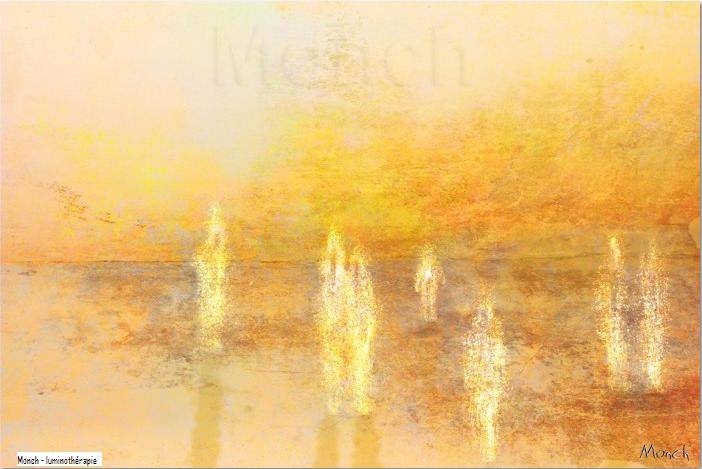
You, Dear Reader, are much needed and appreciated.
Everything written requires a reader to make it whole. The writer begins, then you, dear reader, take in the idea and its image, and so become the continuation of its breath. Please subscribe so that my words can breathe. Consider this my hand, reaching out to yours.
